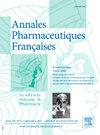Evaluation of cilnidipine-loaded self-micro-emulsifying drug delivery system (SMEDDS) by quantification of comparative pharmacokinetic parameters using validated LC-ESI-MS/MS bioanalytical method and pharmacodynamic assessment
IF 1
Q4 PHARMACOLOGY & PHARMACY
引用次数: 0
Abstract
Objective
Regardless of having desired therapeutic properties many of the recently approved drugs are removed from the developmental pipeline for their clinical use due to low solubility and permeability. Conventional dosage forms are found relatively unsuitable for achieving desired pharmacokinetic and pharmacodynamics profiles. Cilnidipine is 1,4 dihydropyridine derivative calcium channel blocker used for the treatment of hypertension.
Method
The aim and objective of this study was to develop a precise and significant method in LC-MS/MS for quantification of pharmacokinetic parameters of a cilnidipine-loaded self-micro-emulsifying drug delivery system in rat plasma and simultaneously assessed pharmacodynamic characters in comparison with the marketed cilnidipine tablet. Another potential aim of this study is to reduce the dose of the drug in order to counter the dose-dependent toxicities related to chronic use. In the present study, the parent and product ion of cilnidipine was m/z 491.3\237.1.
Result
The plasma was extracted by protein precipitation technique. The calibration standard concentrations were 1.875, 3.75, 7.50, 15.00, 30.00, 60.00 ng/mL and LLOQ, low-quality control, middle-quality control and high-quality control were 1.87, 5.62, 22.50, 45.00 ng/mL, respectively. The mobile phase composition was 0.1% formic acid in Milli Q water with 10 mM Ammonium acetate as an aqueous solvent and 0.1% formic acid in methanol as an organic solvent. Following oral administration of optimized formulation Cmax (peak plasma concentration) was achieved 21.02 ± 3.17 ng/mL at 0.866 ± 0.11 h (Tmax), whereas in the case of marketed tablet Cmax (peak plasma concentration) was achieved 10.16 ± 0.89 ng/mL at 0.93 ± 0.11 h (Tmax).
Discussion
The in-vivo characterizations of the optimized SMEDDS showed significantly better pharmacokinetic parameters in Wistar rats and showed almost 2.4 times enhanced relative bioavailability as compared to the marketed tablet of cilnidipine which was observed to be correlating to our findings with noninvasive blood pressure parameter of Wistar rats.
Objectif
Indépendamment de leurs propriétés thérapeutiques souhaitées, de nombreux médicaments récemment approuvés sont retirés du pipeline de développement pour leur utilisation clinique en raison de leur faible solubilité et perméabilité. Les formes posologiques conventionnelles s’avèrent relativement inadaptées pour atteindre les profils pharmacocinétiques et pharmacodynamiques souhaités. La cilnidipine est un inhibiteur calcique dérivé de la 1,4 dihydropyridine utilisé pour le traitement de l’hypertension.
Méthode
Le but et l’objectif de cette étude étaient de développer une méthode précise et significative en LC-MS/MS pour la quantification des paramètres pharmacocinétiques d’un système d’administration de médicaments auto-microémulsifiant chargé de cilnidipine dans le plasma de rat et d’évaluer simultanément les caractères pharmacodynamiques par rapport aux produits commercialisés comprimé de cilnidipine. Un autre objectif potentiel de cette étude est de réduire la dose du médicament afin de contrer les toxicités dose-dépendantes liées à une utilisation chronique. Dans la présente étude, l’ion parent et produit de la cilnidipine était m/z 491,3\237,1.
Résultat
Le plasma a été extrait par technique de précipitation des protéines. Les concentrations des standards d’étalonnage étaient de 1,875, 3,75, 7,50, 15,00, 30,00, 60,00 ng/mL et LLOQ, LQC, MQC et HQC étaient respectivement de 1,87, 5,62, 22,50, 45,00 ng/mL. La composition de la phase mobile était de 0,1 % d’acide formique dans de l’eau Milli Q avec 10 mM d’acétate d’ammonium comme solvant aqueux et de 0,1 % d’acide formique dans du méthanol comme solvant organique. Après l’administration orale d’une formulation optimisée, la Cmax (concentration plasmatique maximale) a été atteinte 21,02 ± 3,17 ng/mL à 0,866 ± 0,11 h (Tmax) alors que dans le cas du comprimé commercialisé, la Cmax (concentration plasmatique maximale) a été atteinte de 10,16 ± 0,89 ng/mL à 0,93 ± 0,11 h (Tmax).
Discussion
Ici, les caractérisations in vivo du SMEDDS optimisé montrent des paramètres pharmacocinétiques significativement meilleurs chez les rats Wister et ont montré une biodisponibilité relative presque 2,4 fois améliorée par rapport au comprimé commercialisé de cilnidipine, ce qui s’est avéré corrélé à nos résultats avec la pression artérielle non invasive paramètre des rats Wister.
利用经验证的 LC-ESI-MS/MS 生物分析方法和药效学评估,通过比较药代动力学参数的定量分析,评估负载西尼地平的自微乳化给药系统 (SMEDDS)。
目的:许多新近获批的药物尽管具有理想的治疗特性,但由于溶解度和渗透性较低,在临床应用中被从研发管道中剔除。西尼地平是一种 1,4-二氢吡啶衍生物钙通道阻滞剂,用于治疗高血压:本研究的目的和目标是开发一种精确、有效的 LC-MS/MS 方法,用于定量检测大鼠血浆中含西尼地平的自体微乳化给药系统的药代动力学参数,并同时评估与市场上销售的西尼地平片剂相比的药效学特征。这项研究的另一个潜在目的是减少药物剂量,以应对与长期用药有关的剂量依赖性毒性。在本研究中,西尼地平的母离子和产物离子为 m/z 491.3\237.1.结果:采用蛋白沉淀技术提取血浆。标准品浓度为1.875、3.75、7.50、15.00、30.00、60.00 ng/ml,低质对照品、中质对照品和高质对照品的定量限分别为1.87、5.62、22.50、45.00ng/ml。流动相组成为 0.1% 甲酸溶于含 10mM 乙酸铵的 Milli Q 水作为水溶剂,0.1% 甲酸溶于甲醇作为有机溶剂。口服优化制剂后,在 0.866±0.11 小时(Tmax)达到 21.02±3.17 纳克/毫升的 Cmax(血浆浓度峰值),而市场上销售的片剂在 0.93±0.11 小时(Tmax)达到 10.16±0.89 纳克/毫升的 Cmax(血浆浓度峰值):优化后的 SMEDDS 在 Wistar 大鼠体内的药代动力学参数明显更好,与西尼地平的市售片剂相比,其相对生物利用度几乎提高了 2.4 倍,这与我们对 Wistar 大鼠无创血压参数的研究结果是一致的。
本文章由计算机程序翻译,如有差异,请以英文原文为准。
求助全文
约1分钟内获得全文
求助全文
来源期刊

Annales pharmaceutiques francaises
PHARMACOLOGY & PHARMACY-
CiteScore
1.70
自引率
7.70%
发文量
98
期刊介绍:
This journal proposes a scientific information validated and indexed to be informed about the last research works in all the domains interesting the pharmacy. The original works, general reviews, the focusing, the brief notes, subjected by the best academics and the professionals, propose a synthetic approach of the last progress accomplished in the concerned sectors. The thematic Sessions and the – life of the Academy – resume the communications which, presented in front of the national Academy of pharmacy, are in the heart of the current events.
 求助内容:
求助内容: 应助结果提醒方式:
应助结果提醒方式:


